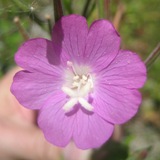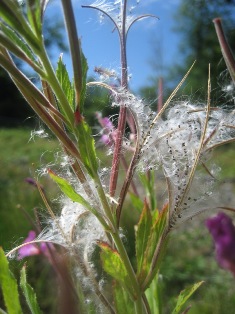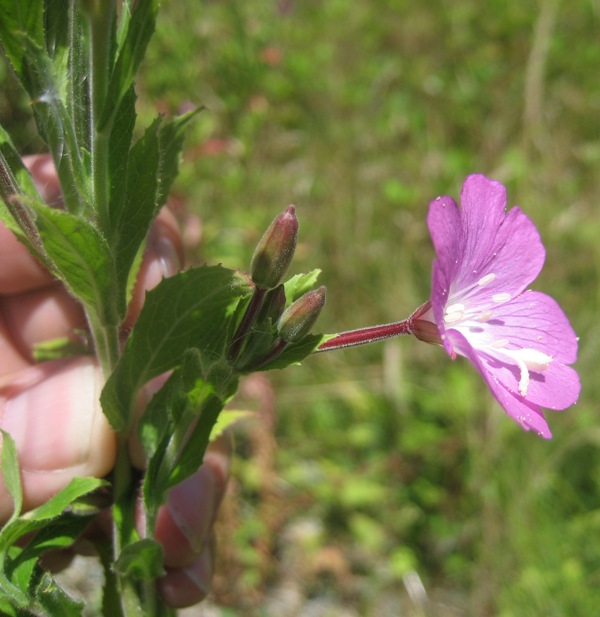Hairy willow-herb identification and control
Epilobium hirsutum, Onagraceae Family

Hairy willow-herb is a Eurasian relative of our native fireweed that can invade and overwhelm moist areas and shorelines. It invades the same types of areas as purple loosestrife and can reduce wetland and shoreline habitat in much the same way. In King County, Washington, hairy willow-herb is only present in a few locations, so we are actively looking for it and working to eradicate it where we find it.
Legal status in King County, Washington
Hairy willow-herb is aClass B Noxious Weed in Washington State and control of this weed is required in King County according to Washington's noxious weed law. Public and private landowners need to control this plant when it occurs on their land.
Although this plant was originally used as an ornamental, sometimes as an alternative to purple loosestrife, it is now illegal to buy or sell hairy willow-herb in Washington State. This species is on the Washington quarantine list (known as the prohibited plants list) and it is prohibited to transport, buy, sell, offer for sale, or to distribute plants or plant parts of this species, into or within the state of Washington. It is further prohibited to intentionally transplant wild plants and/or plant parts of this species within the state of Washington. All populations of hairy willow-herb should be removed and seeding should be prevented.
For more information see Noxious weed lists and laws.
Identification (see below for more photos)
- Semi-aquatic perennial herb covered with soft hairs
- Grows up to 6 feet tall
- Stems are erect and branched
- Showy pink-purple flowers with white centers and notched petals
- Leaves are opposite, lance-shaped with toothed edges, and attach directly on the stem
- Long, narrow seed pods that split open to release numerous seeds with long white hairs


Habitat and impact

Found in low pastures, ditches, wetlands, stream banks, fields and meadows. Often found growing in the same habitat as and can co-exist with purple loosestrife. Hairy willow-herb can out-grow purple loosestrife in the fall, although the reverse is true in the spring. Prefers sunny, open spaces but is somewhat shade-tolerant once established.
Aggressive growth crowds out native wetland plants. Dense stands can impede water flow in waterways and wetlands. Can spread to undisturbed areas and invade into existing vegetation.
Growth and reproduction

Hairy willow-herb reproduces by wind dispersed seeds as well as vegetatively by thick rhizomes (underground stems). Flowers July through August. Tends to grow rapidly and spread most in early autumn. Tolerant of flooded soils. Rhizomes can grow submerged in water or water-saturated soils, but can also spread into meadows and other upland areas.
Control
Most control methods will need to be repeated over several years to be successful. Due to the highly invasive nature of hairy willow-herb, off-site composting is not recommended. Either destroy plants on-site or carefully dispose of with regular garbage.
Make sure to have a long-term plan to ensure success, protect native and beneficial species while doing the control, and start in the least infested areas first and then move into the more heavily infested areas.

Small infestations can be dug up. Make sure to remove all of the roots and rhizomes to prevent plants from re-sprouting. Bag and dispose of all plant material or destroy on-site. Do not take off-site unless material is contained and discarded with the garbage. Seeds spread easily on the wind so if plants are in seed, place bag over plant carefully and cut off the stems before removing the roots.
For larger infestations, chemical control may be more cost-effective than manual removal. However, in wet areas, only state-approved aquatic herbicides can be used and state and local permits will probably be needed. For more information or a site-specific recommendation in King County, Washington, contact the noxious weed program. For information in other locations, contact your local weed board or water quality permitting agency.
Additional information on hairy willow-herb
- Washington State Noxious Weed Control Board (external link)
- King County's Hairy Willowherb Weed Alert (download Acrobat file)
- Whatcom County Noxious Weed Control Board's Hairy Willow-herb Fact Sheet (external link)
- University of Washington Burke Museum Herbarium Image Collection - Epilobium hirsutum (external link)
- Google Images for Epilobium hirsutum (external link)
- CalPhotos for Epilobium hirsutum (external link)
What to do if you find this plant in King County, Washington
Please notify us if you see hairy willow-herb growing in King County. Our program staff can provide the property owner or appropriate public agency with site-specific advice on how best to remove it. Also, because hairy willow-herb is not established in King County, we have an opportunity to stop it from spreading if we act quickly. We map all known locations of regulated noxious weeds such as hairy willow-herb in order to help us and others locate new infestations in time to control them.
Hairy willow-herb photos





Report hairy willow-herb in King County, Washington
- Please notify us through our online infestation form
Locate hairy willow-herb in King County, Washington
- Use our interactive noxious weed map and search
for hairy willow-herb
Related information
Related agencies
Program offices are located at 201 S. Jackson St., Suite 600, Seattle, WA 98104. To contact staff, see the Noxious Weed Control Program Directory, send an email, or call 206-477-WEED (206-477-9333).

 Translate
Translate